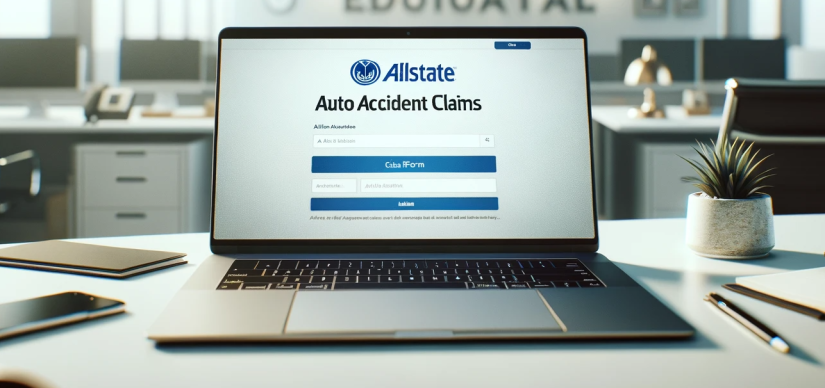Allstate Car Accident Claims & Settlements Guide (2024)
January 3, 2024

In this post, you’ll learn everything you need to know about Allstate Car Accident Claims and Settlements in Texas.
Here is an overview:
- Key Takeaways
- About Allstate
- Allstate’s Market Size and Ranking
- Memorable Ad Campaigns and Spokespersons
- Distinctive Features of Allstate
- Unique Terms and Conditions in Allstate’s Policies
- Allstate’s Personal Injury Claims Process After a Car Accident
- Filing a Claim with Allstate
- Documentation Requirements
- The Role of Claims Adjusters
- Understanding the Evaluation Process
- Time Frame for Claim Processing
- Settlement and Resolution
- How to Negotiate with Allstate After a Car Accident
- Examples of Verdicts and Settlements in Allstate Personal Injury Cases
- Controversies Involving Allstate
- McKinsey & Co.’s Role in Redefining Allstate’s Claims Process
- Low-Ball Settlement Offers
- Hardball Litigation
- Delay Tactics in Claims Processing
- Accusations of Overcharging
- From Good Hands to Boxing Gloves
- Litigating Against Allstate in Texas
Key Takeaways
- Allstate ranks fourth in the U.S. auto insurance market with a 10.69% share and $28.7 billion in premiums (2022).
- Famous for the “You’re in good hands” slogan and “Mayhem” ad campaigns.
- Allstate has been involved in controversies over low-ball settlement offers, hard-ball litigation tactics, delay tactics, and overcharging customers.
- Allstate often settles claims before lawsuits if their insured is clearly at fault and the claim exceeds policy limits.
- The company employs aggressive defense tactics in litigation, including social media and video surveillance.
About Allstate
Allstate’s Market Size and Ranking
- Allstate is a major player in the U.S. auto insurance market, ranked as the fourth largest among auto insurers.
- It covers millions of vehicles across the country, indicating a significant influence on the auto insurance industry.
- Allstate’s market share in the US is 10.69%.
- In 2022, Allstate collected auto insurance premiums of $28,744,785,355.
Memorable Ad Campaigns and Spokespersons
- Allstate is renowned for its memorable marketing, including the iconic “You’re in good hands” slogan.
- The “Mayhem” campaign, portraying the unpredictability of accidents, has been particularly impactful in highlighting the need for reliable insurance.
- These campaigns reflect Allstate’s commitment to brand recognition and customer assurance.
Distinctive Features of Allstate
- Allstate distinguishes itself with unique offerings like the Drivewise program, which rewards safe driving.
- The “Accident Forgiveness” policy is another notable feature, preventing rate increases after a first accident under certain conditions.
- Such features can significantly impact a policyholder’s experience, especially in the context of claims and settlements.
Unique Terms and Conditions in Allstate’s Policies
- Allstate’s policies often include specific terms that can affect the claims process, like coverage limits and deductible options.
- Understanding the nuances of these terms is crucial for policyholders, especially when filing a claim.
- Special endorsements or riders, like roadside assistance or rental reimbursement, can also influence the handling of claims.
For more detailed information on Allstate’s market position, advertising strategies, and unique policy features, check out Allstate’s Wikipedia page and other online resources.
Allstate’s Personal Injury Claims Process After a Car Accident

Filing a Claim with Allstate
- Initiating a claim with Allstate can be done online, via phone, or through their mobile app.
- Essential information includes details of the accident, policy number, and information about the other party involved.
- Prompt reporting is crucial for a smooth claims process.
Documentation Requirements
- Necessary documents typically include the accident report, photographs of the scene and damages, and personal identification.
- In case of personal injury, medical records and bills are vital.
- Witness statements and any police reports can significantly bolster the claim.
The Role of Claims Adjusters
- Once a claim is filed, Allstate assigns a claims adjuster to handle the case.
- The adjuster evaluates the claim, inspects vehicle damage, and may interview witnesses or involved parties.
- Communication with the adjuster is key, as they will guide you through the process and provide updates.
Understanding the Evaluation Process
- Allstate assesses claims based on policy coverage, fault determination, and damage assessment.
- The company may also consider any state-specific laws and regulations that apply.
- Understanding this process can help in setting realistic expectations.
Time Frame for Claim Processing
- The time it takes to process a claim can vary based on the complexity of the case.
- Simple claims might be resolved quickly, while more complex cases, especially those involving injuries, can take longer.
- Keeping track of the claim and staying in contact with the adjuster can help expedite the process.
Settlement and Resolution
- Once the evaluation is complete, Allstate will offer a settlement based on their assessment.
- It’s important to review the settlement offer carefully and understand how it aligns with the policy terms and the damages incurred.
- If the settlement offer is insufficient, policyholders have the option to negotiate or seek legal advice.
For an in-depth understanding of Allstate’s personal injury claims process, and to ensure you have all the necessary information and documentation, visit Allstate’s claim center.
How to Negotiate with Allstate After a Car Accident

Steps Post-Accident
- Immediately document the accident scene with photos, including vehicle positions and any visible injuries.
- Gather contact information from witnesses and other parties involved in the accident.
- Seek medical attention, even for minor injuries, as medical records are key in personal injury claims.
The Importance of Not Giving Recorded Statements
- Avoid giving a recorded statement to Allstate without legal advice.
- Insurance adjusters may use these statements to challenge your claim.
- Politely decline or state you will provide information after consulting an attorney.
Gathering Evidence
- Collect all relevant documents, including police reports, medical records, and receipts for expenses related to the accident.
- Detailed records strengthen your position in negotiations.
- Maintain a log of symptoms and challenges faced due to the accident.
Warnings Against Accepting Early Settlement Offers
- Allstate may offer a quick settlement, which is often less than the claim’s full value.
- Accepting this initial offer waives your right to seek additional compensation.
- Consult a lawyer before accepting any offers.
The Role of a Lawyer
- A personal injury lawyer can evaluate the fairness of settlement offers.
- Lawyers are skilled in negotiating with insurance companies like Allstate.
- Legal assistance ensures your rights are protected and enhances the likelihood of a favorable outcome.
Staying Informed and Proactive
- Keep abreast of your claim’s status by regular communication with Allstate.
- Respond promptly to requests for additional information.
- Be proactive in following up on your claim.
For a deeper understanding of how to effectively negotiate with Allstate after a car accident, consider visiting Wagoner Law Firm’s guide, which provides detailed advice and examples.
Examples of Verdicts and Settlements in Allstate Personal Injury Cases

Allen v. Martinez
- Background: Patrick Allen was in a car crash in 2016. Francisco Javier Martinez hit him. Martinez was insured by Allstate.
- Injuries and Treatment: Allen had back, neck, and arm pain. He got care from a doctor. His treatment included chiropractic care and injections.
- Pre-Trial Settlements: Allen settled with Martinez for his policy limit. He then went after Allstate for more money under his underinsured motorist coverage with Allstate.
- Trial Against Allstate: The trial was in two parts. First was for the car crash. Next was for Allstate’s bad faith.
- Allstate’s Defense: Allstate said Martinez was not to blame. They also said Allen’s injuries were not from the crash.
- Jury Verdict: The jury said Martinez was at fault. They gave Allen $400,364.04. This covered past and future medical costs and pain.
- Bad Faith Claim: The case against Allstate for bad faith was settled. The settlement was $153,449.48.
- Citation: Cause No. 2017-007700-2, in Tarrant County, Texas Court at Law No. 2, September 20, 2023.
In summary, Allen faced a tough legal fight against Allstate. Allstate defended its insured, but had to pay in the end. This case shows how hard it can be to get money from Allstate after a crash.
Avila v. Allstate
- Incident Details: Ana Avila was hit in 2015 in Dallas. A driver ignored a stop sign.
- Avila’s Injuries: She suffered back pain, a hand laceration, and other injuries.
- Initial Settlement: Avila settled with the at-fault driver for $30,000.
- Claim Against Allstate: Avila filed for underinsured motorist benefits. Allstate paid $2,500 initially.
- Legal Action: Avila sued Allstate for additional benefits and bad faith.
- Trial Focus: The trial was on underinsured motorist claims only.
- Allstate’s Admission: Allstate admitted the other driver’s fault.
- Injury and Treatment Details: Avila had ER treatment, chiropractic sessions, and an MRI showing degenerative changes.
- Defense Arguments: Allstate argued Avila’s injuries were minor and questioned treatment gaps.
- Jury’s Decision: The jury awarded Avila $48,000 in total damages.
- Damage Breakdown: $18,000 for past medical costs, $25,000 for future medical costs, $1,000 for past physical impairment, and $4,000 for past physical pain and mental anguish.
- Citation: Cause No. DC-16-02308, in the 95th Judicial District Court of Dallas County, Texas, February 06, 2018.
This case illustrates the complexities in proving the extent of injuries and the corresponding compensation in underinsured motorist claims. Avila’s victory demonstrates the importance of detailed medical documentation in such cases.
Understanding the dynamics of previous settlements and verdicts in cases involving Allstate can provide valuable insights for those currently navigating the claims process. These examples illustrate the range of possible outcomes and the factors that can influence the final settlement amount.
Bulan v. Allstate
- Accident Details: Mabeleine Bulan was rear-ended in 2011. The impact pushed her car into another vehicle. Bulan’s car was towed due to damage.
- Initial Settlement: Bulan settled with the other driver for $30,000.
- Claims with Allstate: She filed an underinsured motorist claim with Allstate, which remained unresolved.
- Legal Action: Bulan sued Allstate for underinsured motorist benefits.
- Injuries and Treatment: Bulan received ER treatment for neck pain and underwent chiropractic treatment and epidural injections. MRIs showed disc bulges and herniation.
- Allstate’s Position: Allstate admitted the other driver’s fault but disputed Bulan’s claimed damages.
- Defense Strategy: Allstate questioned the necessity of Bulan’s treatments and their connection to the accident.
- Jury Verdict: The jury awarded Bulan $56,000, considering past medical costs and physical pain.
- Citation: Cause No. 15-DCV-223725, in the 400th Judicial District Court of Fort Bend County, Texas, July 20, 2016.
This case highlights the challenges in proving the extent and necessity of medical treatment in underinsured motorist claims, especially when insurance companies like Allstate dispute the claimed damages.
Controversies Involving Allstate
McKinsey & Co.’s Role in Redefining Allstate’s Claims Process
In the early 1990s, Allstate Insurance sought to revamp its auto accident claim handling processes. They turned to McKinsey & Co. Consulting for guidance, leading to the development of the Claim Core Process Redesign (CCPR). This initiative was intended to improve efficiency but soon drew criticism for favoring profits over people.
Low-Ball Settlement Offers
Allstate’s new approach included offering policyholders low-ball settlements. These offers, calculated using the Colossus software, were often much lower than what was needed for the claimants’ medical bills and lost wages. Accepting these offers meant quick resolution but with insufficient financial support.
Hardball Litigation
When claimants rejected these low offers, Allstate shifted to a more aggressive tactic: hard-ball litigation. This strategy involved prolonged and costly legal battles, aimed more at wearing down the claimant than offering a fair settlement.
Delay Tactics in Claims Processing
Allstate also adopted delay tactics, infamously dubbed the “three Ds”: deny, delay, and defend. This approach was exemplified by a McKinsey-prepared slide showing an alligator with the caption “sit and wait,” symbolizing the strategy of prolonging claims to discourage claimants.
Accusations of Overcharging
Adding to the controversy, Allstate faced accusations of overcharging policyholders in several states, such as Texas. The complaint filed in one Texas lawsuit alleged:
Allstate essentially has carte blanche to pick the rate that it will charge each policyholder.
Complaint, Shannon v. Allstate, in the U.S. District Court for the Western District of Texas
Here is a copy of the Complaint:
From Good Hands to Boxing Gloves
“From Good Hands to Boxing Gloves” by David Berardinelli is a critical examination of Allstate’s transformation in handling insurance claims. It focuses on the company’s shift from customer-focused practices to a more profit-oriented approach after consulting with McKinsey & Co.
The book details how these changes affected policyholders, leading to tougher claim settlements and legal disputes. It offers an in-depth look at the insurance industry’s strategies and the impact on consumer trust and legal ethics.
Litigating Against Allstate in Texas
As a car accident lawyer in Texas, my interactions with Allstate in personal injury cases have been a mix of straightforward negotiations and challenging tactics.
Allstate Insurance Policy Limits
Allstate’s insurance policies in Texas usually have minimum limits of $30,000 per person, $60,000 per incident. Allstate focuses on volume and competes on low-cost premiums.
Early Stage Settlement Negotiations with Allstate
In most cases, my experience with Allstate has been relatively easy when it comes to settling claims before a lawsuit has been filed. In cases where Allstate’s insured is clearly at fault and the claimant’s medical expenses exceed the Allstate policy limit, Allstate will typically pay the policy limit without the need for a lawsuit.
Aggressive Litigation Tactics
Allstate’s legal strategies can be tough. They often use social media and video surveillance to challenge the plaintiff’s claims. This approach can be seen as underhanded and aims to discredit the injured party.
- Social Media Surveillance:
- Allstate extensively scrutinizes plaintiffs’ social media.
- They use embarrassing, irrelevant content in depositions.
- This tactic aims to undermine the plaintiff’s character and injury claims.
- Video Surveillance:
- Efforts to catch plaintiffs appearing less injured.
- This is done to question the severity of their injuries.
Mediation and Settlement Negotiations with Allstate
Mediation, a mandatory process in Texas car accident lawsuits, has its own challenges with Allstate.
- Resistance in Mediation: Some lawyers accuse Allstate of not engaging in good faith negotiations during mediation.
- Limited Authority of In-House Lawyers: Allstate’s lawyers have been accused of occasionally arriving for mediation with no real power to make settlement offers, stalling the negotiation process.
Working against Allstate requires a balanced approach, understanding their willingness for early settlement, but also being prepared for their tougher tactics in litigation and mediation. Navigating these challenges is key to achieving fair outcomes for clients.